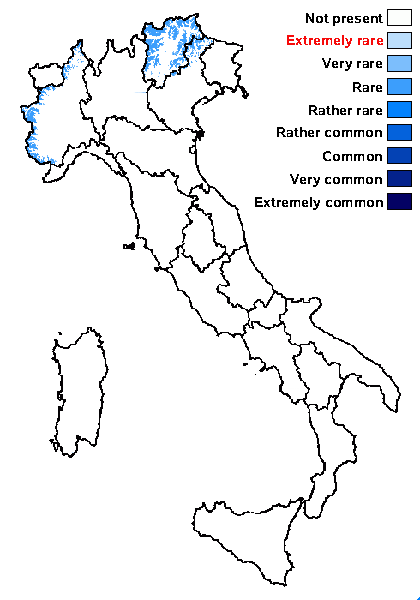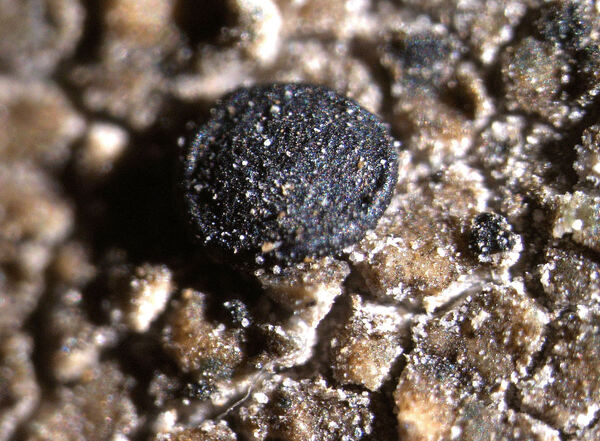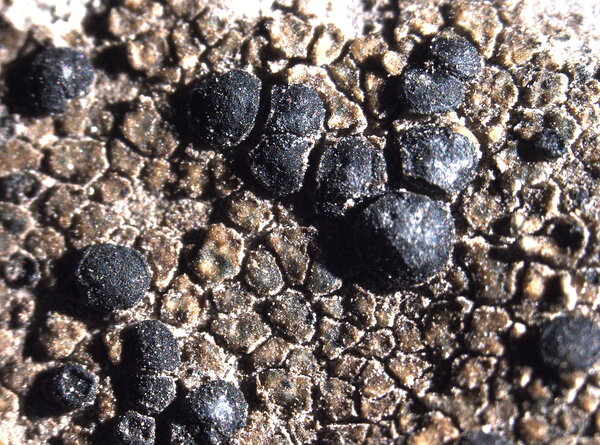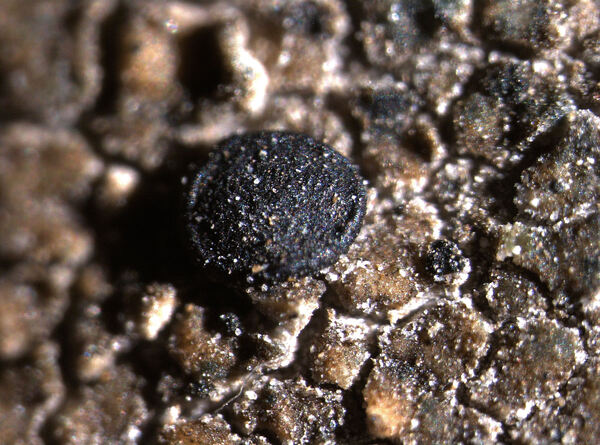Farnoldia dissipabilis (Nyl.) Hertel
Mitt. bot. Staatss. München, 19: 443, 1983. Basionym: Lecidea dissipabilis Nyl. - Flora, 57: 314, 1874.
Synonyms: Lecidea jurana var. sublutescens (Nyl.) Hertel; Lecidea obstans Nyl.; Lecidea sublutescens Nyl.; Melanolecia dissipabilis (Nyl.) Hertel; Tremolecia jurana var. sublutescens (Nyl.) Hertel
Distribution: N - Ven, TAA (Hertel & Schuhwerk 2010, Nascimbene & al. 2022), Piem (TSB 34058).
Description: Thallus crustose, episubstratic, pale yellowish brown or ochre, 0.15-0.4(-0.7) mm thick, areolate, the areoles flat, sometimes with free margins and appearing subsquamulose, contiguous or usually dispersed along cracks in the rock. Medulla white, I- (rarely I+ pale blue). Apothecia lecideine, adnate and constricted at base, black, epruinose, somehow shiny, 0.5-1.5(-2) mm across, with a flat to finally convex disc, and a thin to thick, finally often excluded proper margin. Proper exciple c. 60 µm wide, black, the hyphae 5-9 µm thick, K+ reddish brown; epithecium blue-green or (in old apothecia only) greenish brown, K-, with crystals; hymenium colourless or greenish in upper part, 75-110(-130) µm high; paraphyses coherent, branched and anastomosing, 1.7-2.2 µm thick at mid-level, the apical cell to 3 µm wide; hypothecium dark brown (in young apothecia) to brown-black, K+ reddish brown. Asci 8-spored, clavate, with a I+ pale blue tholus and a central amyloid tube, approaching the Porpidia-type. Ascospores 1-celled, hyaline, ellipsoid, 12-19(-24) x (6-)8-13(-14) µm, halonate when young. Pycnidia black, immersed, globose. Conidia bacilliform, 4.5-7.5 µm long. Photobiont chlorococcoid. Spot tests: thallus K-, C-, KC-, P-, UV-. Chemistry: without lichen substances.Note: on calciferous rocks, especially in rock fissures and on steeply inclined to slightly overhanging surfaces near or above treeline; very closely related to F. jurana, this taxon, known from the central European mountains (Alps, Carpathians), awaits further study.
Growth form: Crustose
Substrata: rocks
Photobiont: green algae other than Trentepohlia
Reproductive strategy: mainly sexual
Poorly known taxon in need of further study
Commonnes-rarity: (info)
Alpine belt: rare
Subalpine belt: very rare
Oromediterranean belt: absent
Montane belt: absent
Submediterranean belt: absent
Padanian area: absent
Humid submediterranean belt: absent
Humid mediterranean belt: absent
Dry mediterranean belt: absent

Predictive model
Herbarium samples
Growth form: Crustose
Substrata: rocks
Photobiont: green algae other than Trentepohlia
Reproductive strategy: mainly sexual
Poorly known taxon in need of further study
Commonnes-rarity: (info)
Alpine belt: rare
Subalpine belt: very rare
Oromediterranean belt: absent
Montane belt: absent
Submediterranean belt: absent
Padanian area: absent
Humid submediterranean belt: absent
Humid mediterranean belt: absent
Dry mediterranean belt: absent

Predictive model
| Herbarium samples |
 INDEX FUNGORUM
INDEX FUNGORUM
 GBIF
GBIF
 DOLICHENS
DOLICHENS





